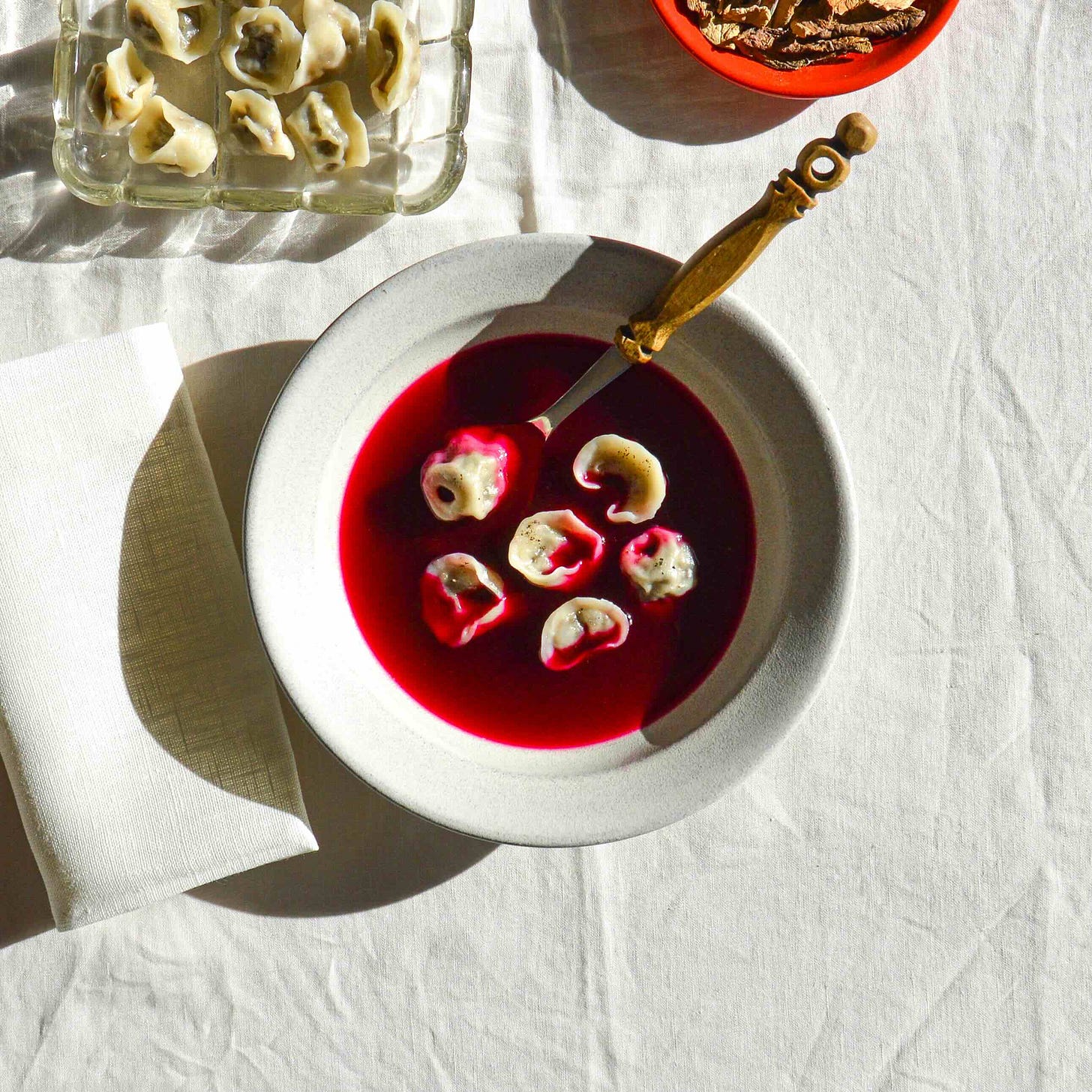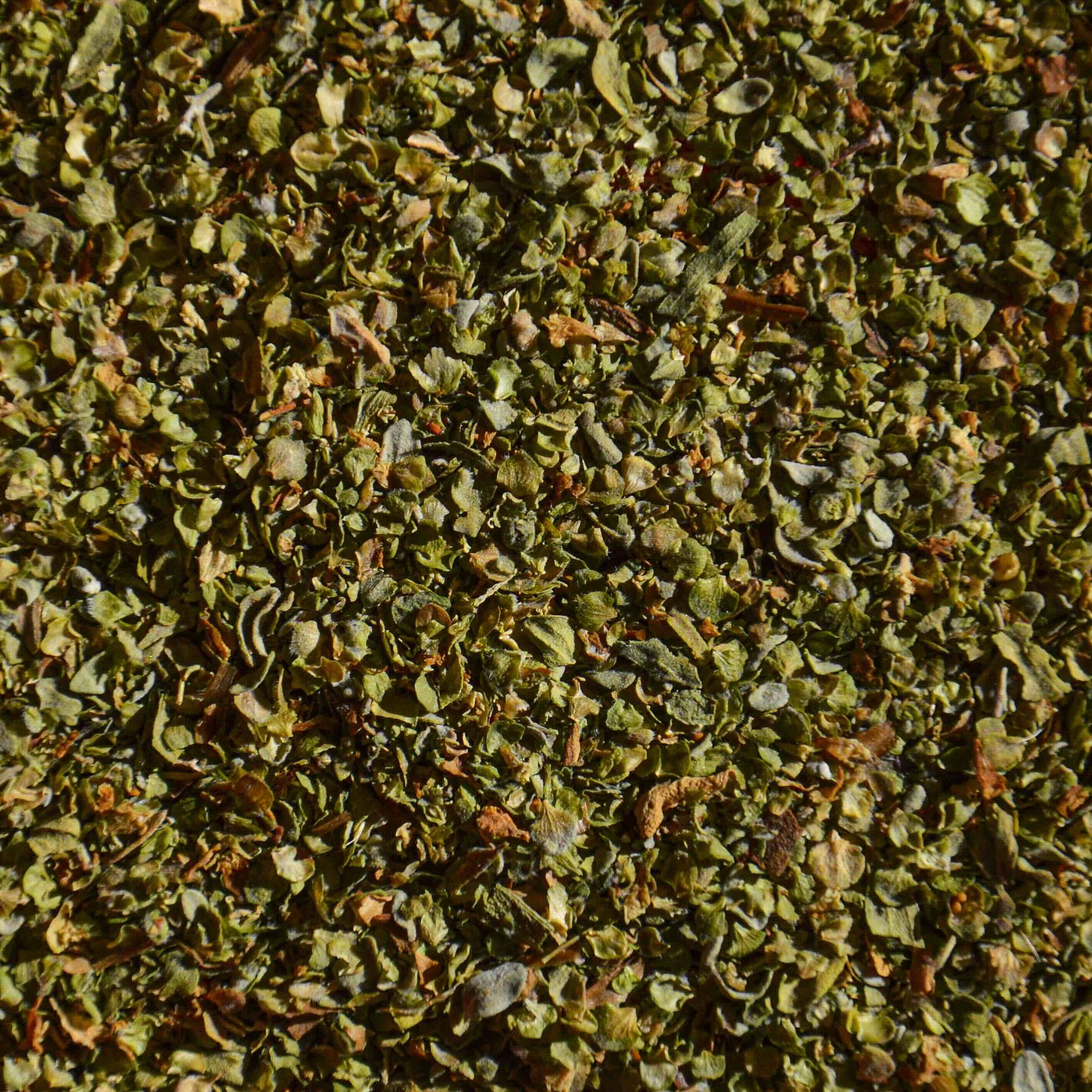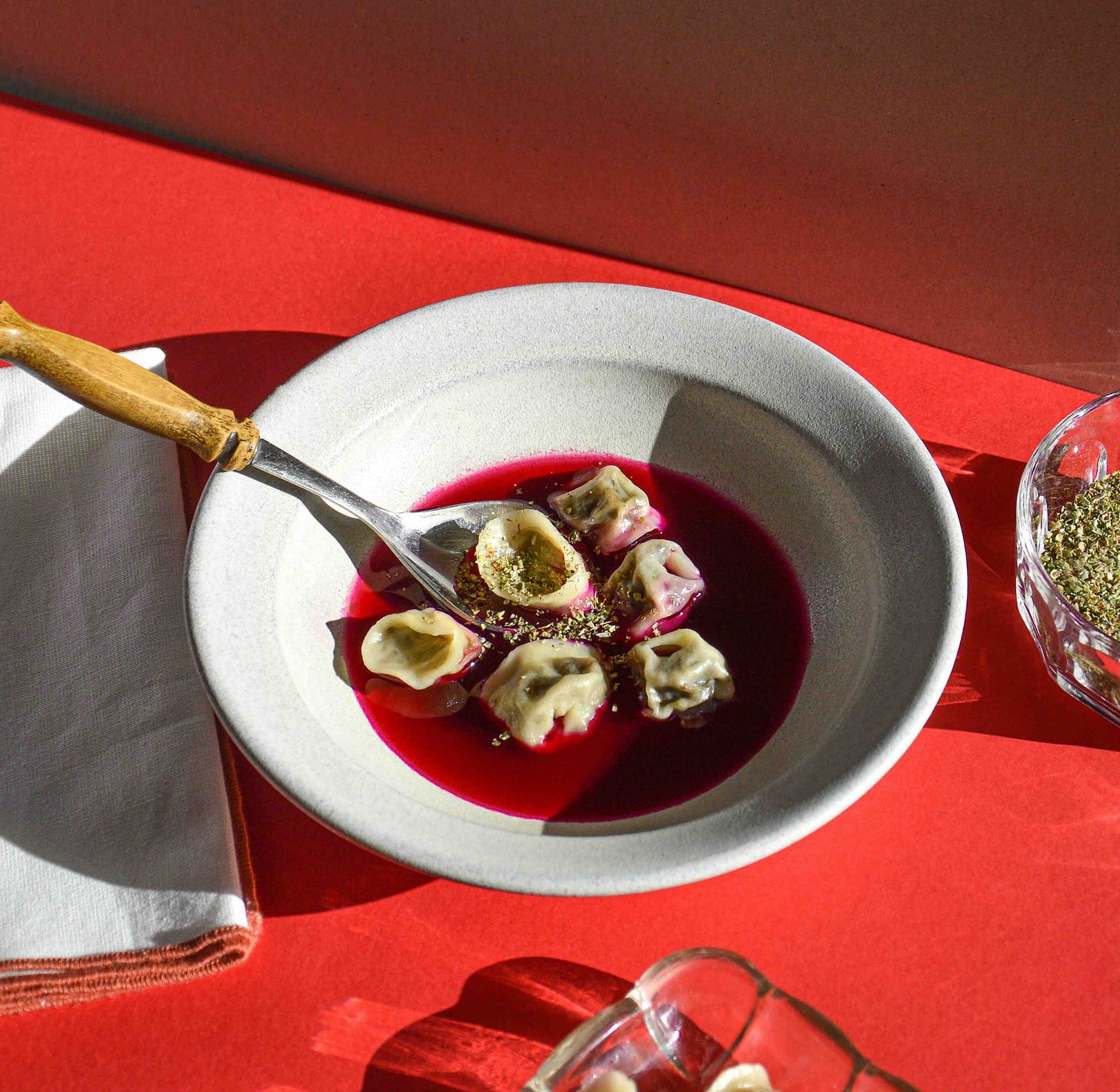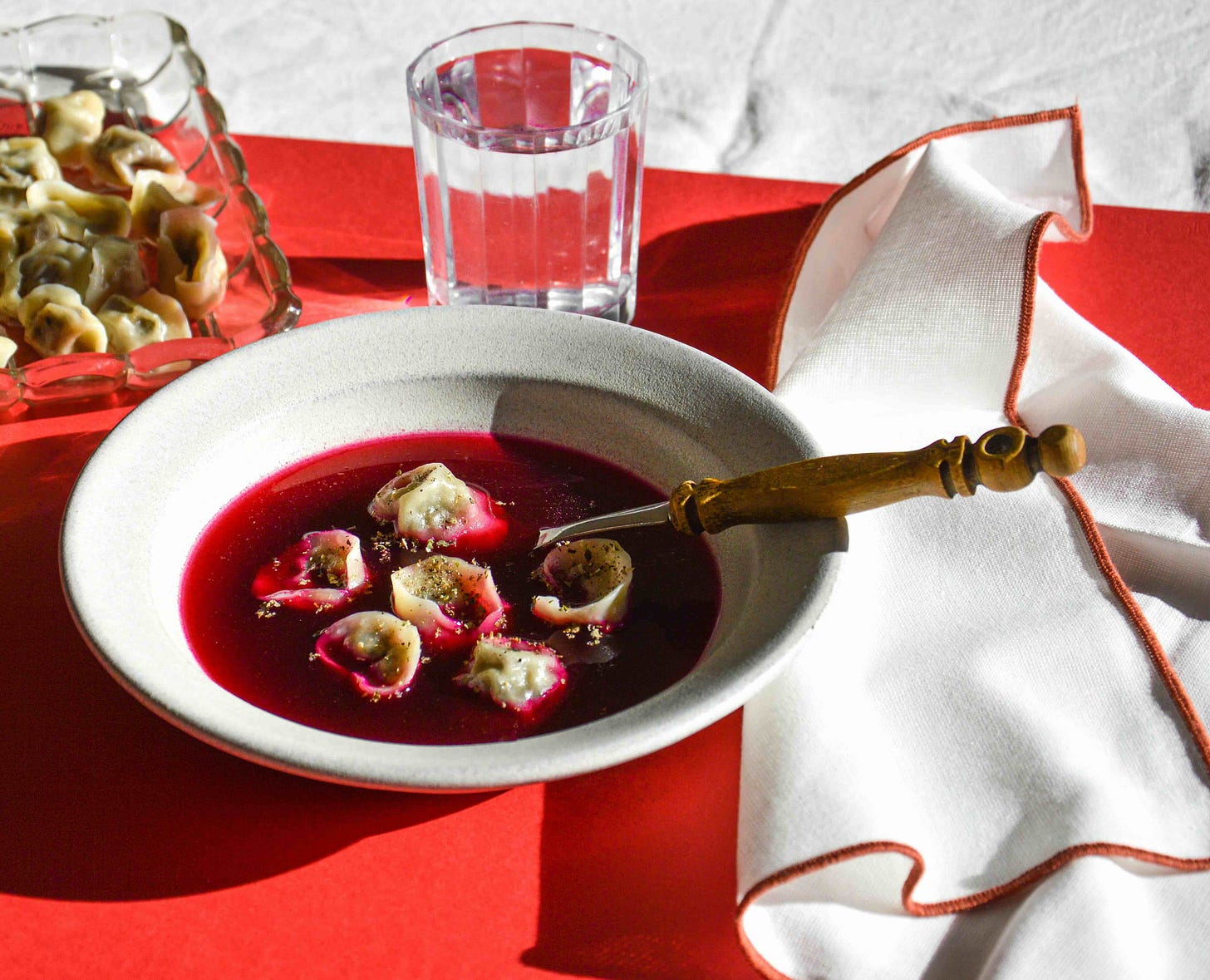barszcz z uszkami
a recipe for a vegan borscht with dumplings filled with porcini and bay boletes
There’s nothing quite like a warm bowl of soup on a cold winter day and one of my favourites has to be red borscht. Beetroot soups are often associated with Eastern Europe, particularly Ukraine and Russia, but through migration, variations of borscht have made their way around the world. Chinese adaptation in cities such as Hong Kong, known as luo song tang, is prepared with beef oxtail, and tomatoes instead of beetroots, cabbage, potatoes, garlic, and onion. In Iran, you might find a version made with vegetable stock, beetroots, lentils and a blend of spices.
In Poland, there are three main types of beet-based soups that my family has often cooked. First, there’s chłodnik, a refreshing cold soup prepared with young beet leaves, grated beetroots, and cucumber, all mixed with yoghurt and kefir. It’s garnished with a medium-boiled egg, herbs and pickles. Then, there’s the everyday hot and hearty version, a Ukrainian-style borscht, made with meat, usually pork ribs, beetroots, cabbage, potatoes and carrots. But the one I want to focus on here we call barszcz czerwony in Poland, a vibrant, clear ruby-coloured soup made with vegetable stock, fruits, dried mushrooms, spices such as allspice, bay leaves and cloves. And it’s enriched with flavorful zakwas, a fermented beet juice that gives the soup its signature depth. Barszcz czerwony is traditionally served with croquettes filled with sauerkraut, mushrooms, and onions, or, my personal favourite - uszka - tiny dumplings filled with dried mushrooms and onions. This dish is especially popular during Christmas Eve, known as Wigilia when it's enjoyed alongside many other traditional Polish dishes.
Barszcz czerwony z uszkami
Serve: 6
Ingredients:
Fermented beetroot juice
8 beetroots (about 2kg)
5 garlic cloves (about 25g)
6 bay leaves
10 black peppercorns
2 tablespoons of fine sea salt (about 15g)
1l warm water
Dumplings (60 pieces)
Dough
150g finely ground flour (such as 00)
80g warm water
fine sea salt
Filling
20g dried porcini
20g dried bay boletes
1/2 white onion (100g)
40g unsalted butter
50g mushroom water (from soaking the dried mushrooms)
10g breadcrumbs
fine sea salt
black pepper
Borscht
2l water
1,5kg beetroots (about 6 pieces)
1 white onion
1 carrot
1 celery
1/2 apple (sweet variety)
1 slice of orange
5 garlic cloves
1 fresh red chilli
a bunch of parsley
3 bay leaves
4 whole allspice
3 cloves
25 black peppercorns
5g dried porcini
230ml mushroom water (from soaking the mushrooms for the dumpling's filling)
1l fermented beetroot juice
1 teaspoon of marjoram
20g lemon juice
fine sea salt
Extra note
To bring all three components of the dish together, you’ll need a bit of time: about 7 days to ferment the beetroot juice, 2 days to make the borscht once the beetroot juice fermentation is complete, and a day for preparing the dumplings, though they can be easily made in advance and frozen.
For the mushroom filling, it’s best to use dried mushrooms rather than fresh ones, as the flavour is more concentrated.
Method
Fermented beetroot juice
To prevent the fermented beetroot juice from spoiling, it’s essential to thoroughly clean the vessels you’ll be using for fermentation.
Here’s what I do to sanitise the jars. First, select a couple of glass jars with lids - I used one medium and one small. Wash them in hot, soapy water, then, place them in the sink and fill each jar with a small amount of hot water. Close the lid tightly, wearing oven mitts on, and swirl the jar. Don’t fill the glass with hot water more than halfway through if you’re not sure the jar is heat-proof and be cautious not to burn yourself.
After rinsing, place a clean towel on the counter and dry the jars upside down.
Also, ensure the peeler, knife and chopping board are well-cleaned before you begin!
Next, make a brine by heating 1 litre of water with 2 tablespoons of fine sea salt in a pot. Stir until the salt dissolves.
Peel the garlic cloves. If you bought beetroots with leaves attached, cut them off but don’t discard them. You can chop them and make sauté with some garlic and chilli flakes. Peel the beetroots and cut them into large chunks, as shown below. If you don’t want to stain your hands, wear gloves.
Add a layer of beetroot chunks in the jar, followed by garlic, a bay leaf, and black peppercorns. Repeat the process, adding another layer of beetroot and spices, until the jar is full. Be sure to tightly pack the beetroots and spices in the jar.
Pour the warm salty water into the jar, leaving about a 3 cm gap at the top. Tightly close the lid. If any of the ingredients float above the water, press them down with a clean spoon. Let it ferment on the counter for about 7 days or until sour and bubbly.
I fermented the beetroots for 7 days, but the exact time may vary depending on the room temperature. I recommend checking the jar daily to see if bay leaves, peppercorns, garlic and beetroot remain submerged. If they start to float, it’s likely the surface gets mouldy. To prevent this, you can place a clean weight on top, such as a saucer (I haven’t done it as my vegetables were under brine).
After 4 days, taste the brine to see how’s progressing - you should notice bubbles forming on top as shown below. When tasting, remember to wash the spoon with hot soapy water and then scald it in hot water. Once you’re satisfied with the taste, remove any sediment that has formed on the surface, strain the liquid and store it in the fridge.
Mushroom filling
Rinse the dried mushrooms under cold water to get rid of any hidden grit. Rehydrate them in hot water, soaking for 30 minutes.
Remove the mushrooms from the liquid, squeezing them in your hands. Don’t toss away the soaking water - keep it aside for later use, it’s full of flavour!
Slice dried porcini and bay boletes thinly with a sharp knife, then chop them into small cubes. Brunoise white onion.
Add butter to a pan and melt over low heat. Add white onion and sauté until translucent. Add chopped mushrooms, 50g of mushroom soaking water (keep the rest in a jar for later), breadcrumbs and season with salt. Let it cook for around 15 minutes.
Dough for dumplings
Sieve 150g of 00 flour over a bowl. Heat up 80g of water in a small pot with a pinch of salt.
Make a well with a spoon and add warm water to the centre. Stir the flour into the liquid using a fork. Don’t add all the water at once and start with about 3/4 of it. If the flour is too dry, add more liquid.
Place the shaggy dough on the clean counter and start kneading with your hands. Press the heel of your palm in the middle of the dough and start stretching it away from your body. Fold the dough, press down and rotate it. Repeat the process. The process takes about 15 minutes.
Cover the dough with cling film and rest the dough for around 30 minutes on the counter.
Fold dumplings
Prepare a tray and lightly cover it with flour.
Give the dough a couple more kneads and cut it in half. Put one of the halves in clingfilm to prevent drying.
Roll it thinly (about 2 mm) on a clean surface. If the dough sticks to the board, dust some flour underneath and sprinkle some of the flour on the rolling pin. Ensure not to overdo the flour otherwise the dumplings will be hard to seal later.
Using a glass jar with a diameter of about 5 cm cut circles. If you can find a jar or a glass with a thin edge that will be easier to make the cuts.
If it’s your first time, or you want to take time to make the dumplings, remove the dough around the circles, make a rough ball out of it, and place it in cling film. If you leave the dough around the circles while pleating the dumplings uncovered for too long, the dough will dry out.
Prep a teaspoon and two small bowls, one with a mushroom filling and the other with water.
Add a teaspoon of the mushroom filling in the middle of each circle.
Fold the dumpling in half. If the edges are covered in flour, dip your finger in water and then run it along the half edge of the circle. If any filling comes out, press it in gently with your finger, then pinch around to seal. Connect the two ends as shown below. Press again the edges to avoid leaking filling when cooking. Add onto the floured tray and cover with a cloth. Continue pleating the rest of the dumplings, then move on to the second half of the dough.
Bring a pot with water to boil and cook dumplings for a minute and a half. Drain well and place them on a tray. Add about 3 tablespoons of vegetable oil and move the dumplings around to prevent them from sticking. If you don’t use them straight away, lay them on a tray in one layer and freeze once cold.
Borscht
Halve a carrot, an apple and garlic cloves in their skin. Prepare one slice of an orange. Remove a length of 3/4 of the beetroots stalks and peel the roots. Cut the roots into 4 pieces.
Peel the white onion and cut it in half. Place the sides cut side down on a burner grate, turn the heat on medium, and char until the sides get black. Use heat-resistant tongs to move the onion around and be extra careful.
Add all the cut vegetables into a big pot with fresh parsley and one red chilli. Cover them with 2 litres of cold water.
Bring the liquid to a boil, and let it simmer on low heat for about 20 minutes. Add all the aromatics: bay leaves, peppercorns, cloves, allspice, dried porcini and mushrooms water (it should have been left from soaking the dried porcini and bay boletes for the dumpling filling).
Simmer for about 2 hours with a lid slightly open on a very low heat. Keep an eye on the temperature, if the borscht goes too bubble it will change its beautiful ruby colour and aromas.
After 2 hours of cooking, add 1 litre of homemade fermented beetroot juice and season with salt. Cook for another 1 hour, again on a low heat. Once cooked, let it cool, and place it in the refrigerator.
The borscht tastes best after sitting in the fridge for a day or two. I left mine undisturbed for a day.
The next day, reheat the soup to a light simmer. Add lemon juice for more brightness and marjoram for floral notes. The amount of lemon juice added to the borscht depends on the intensity of the fermented beetroot juice. If your beet juice is not sour enough, add more lemon juice.
Discard all the vegetables and the aromatics - you can keep beetroots and make a salad the following day. First use a sieve to fish out the bigger chunks, then strain the whole borscht. Keep in mind to squeeze all the excess liquid from the vegetables and pour it back into the soup. Test the seasoning again, add more acidity or salt if needed.
Serving
Bring a pot with water to a boil and heat the borscht on low until it’s warm.
Once the water starts to boil, add the dumplings and cook for 2 minutes, or until they rise to the top. Strain the dumplings and serve about 10 per person. Ladle hot borscht over the dumplings.
























































